Ivy plants are some of the most versatile and visually appealing greenery found in both indoor and outdoor settings. With their trailing vines, lush foliage, and ability to climb walls, fences, and trellises, they add beauty and depth to any space. There are many types of ivy plants, each with unique leaf shapes, colors, and growth habits. Some varieties are best suited for ground cover, while others excel as houseplants or decorative climbing vines.
Exploring the different types of ivy plants reveals a diverse range of species, from classic English Ivy to exotic Himalayan Ivy. Some have variegated leaves with striking patterns, while others display vibrant seasonal colors that change throughout the year. Certain ivy varieties thrive in shaded areas, making them perfect for low-light gardens, while others prefer bright, indirect sunlight to maintain their vibrant hues. Whether used for erosion control, air purification, or simple aesthetic appeal, ivy plants are a popular choice for many gardeners.
In this guide, we will cover 21 stunning types of ivy plants, complete with pictures and names to help you identify each one. Whether you’re looking for an easy-to-care-for indoor plant or a fast-growing outdoor climber, this list will help you choose the perfect ivy variety for your needs. Let’s dive into the fascinating world of ivy and explore the characteristics that make each type unique!
Different Types of Ivy Plants
North African Ivy
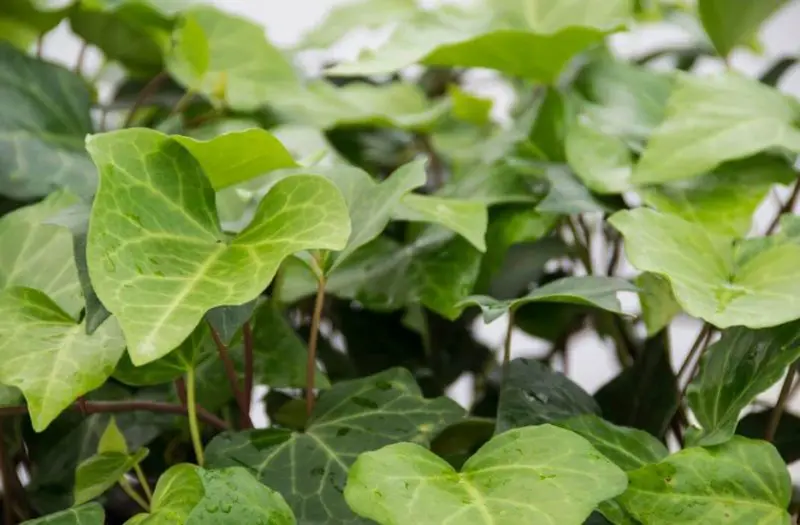
North African Ivy, also known as Canary Island Ivy, is a fast-growing evergreen vine native to North Africa and the Canary Islands. It thrives in USDA hardiness zones 6 to 10, making it adaptable to various climates. This ivy features thick, leathery leaves that are deeply lobed and glossy, adding a lush appearance to any garden setting.
The stems of North African Ivy are strong and sturdy, with a reddish tint that gives them a distinctive look. Unlike many other ivy species, this variety is highly tolerant of direct sunlight, which makes it an excellent choice for outdoor landscaping. It is often used to cover fences, walls, or as a groundcover due to its vigorous spreading nature.
When planting North African Ivy, ensure it has well-drained, moist soil to promote healthy growth. While it can handle full sun better than English Ivy, it may struggle in colder climates. If temperatures drop too low, consider bringing potted plants indoors during winter months to prevent damage.
English Ivy (Hedera helix)
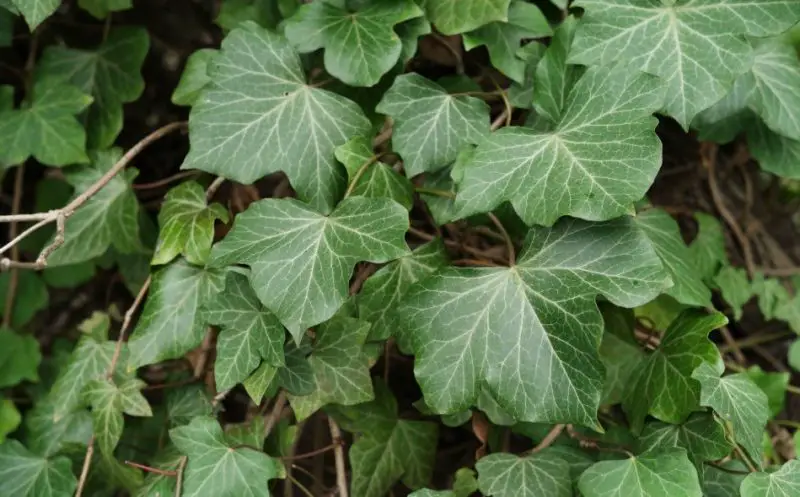
English Ivy is one of the most widely recognized ivy species, known for its aggressive growth and versatility. It comes in two primary forms: the juvenile stage, which features lobed, bright green leaves, and the mature stage, where leaves darken and flowers emerge. This ivy is particularly loved for its ability to climb trellises, walls, and trees with ease.
In its mature phase, English Ivy produces small, greenish-white flowers in the fall, followed by bluish-black berries that attract birds. Its dense foliage makes it an excellent choice for ground cover, helping to prevent soil erosion. Additionally, this plant is often used to decorate fences, arches, and even indoor spaces when grown in hanging baskets.
While it is a hardy plant, English Ivy can become invasive if left unchecked. Regular pruning helps control its spread, ensuring it remains a manageable and attractive addition to your garden. It prefers moist, well-drained soil and thrives in partial to full shade.
Persian Ivy (Hedera colchica)
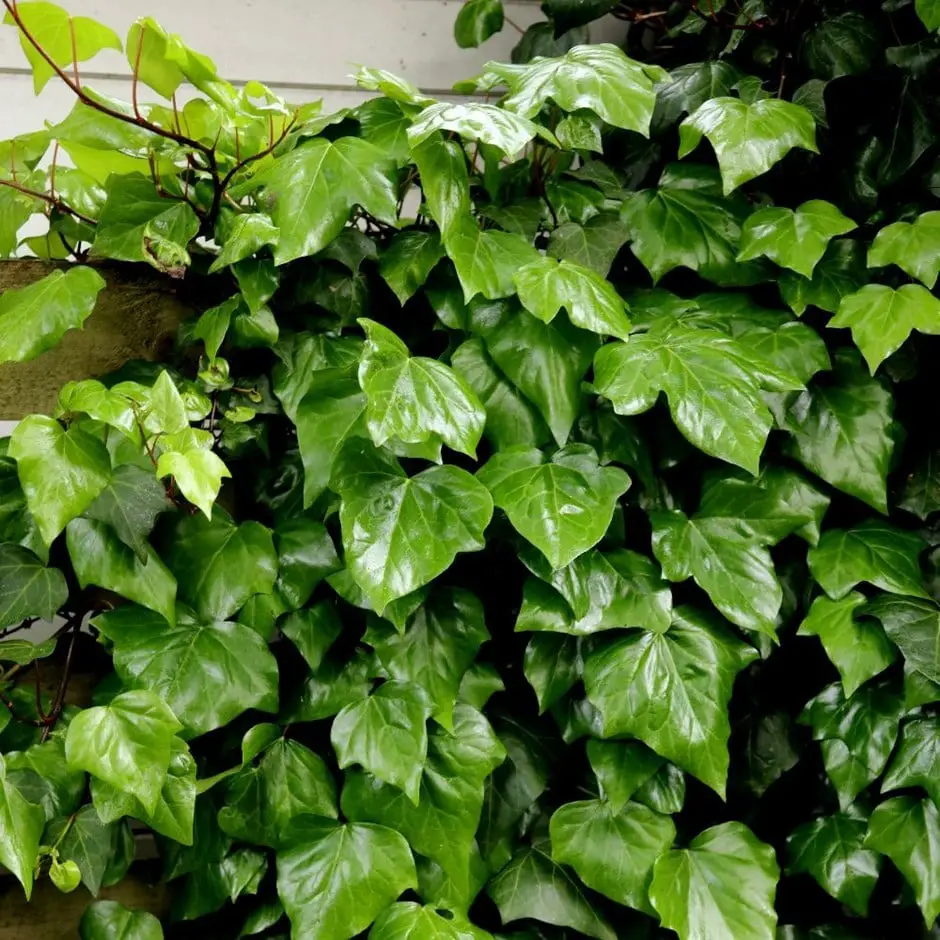
Persian Ivy is a striking ivy species known for its exceptionally large leaves, which can grow between 4 to 10 inches long. These heart-shaped leaves are either solid green or variegated with creamy-yellow edges, adding an ornamental touch to landscapes. It is a hardy variety that flourishes in USDA zones 6 to 9.
This ivy is more drought-tolerant than many other varieties, though it prefers moist, well-drained loamy soil for optimal growth. Persian Ivy is also highly resistant to heat and does well in both sun and shade. It makes an excellent groundcover or wall-climbing plant, providing dense foliage wherever it is planted.
Because of its vigorous growth rate, Persian Ivy requires regular maintenance to prevent it from overwhelming other plants. Pruning ensures that it does not become too invasive, allowing for a controlled and aesthetically pleasing garden design.
Algerian Ivy
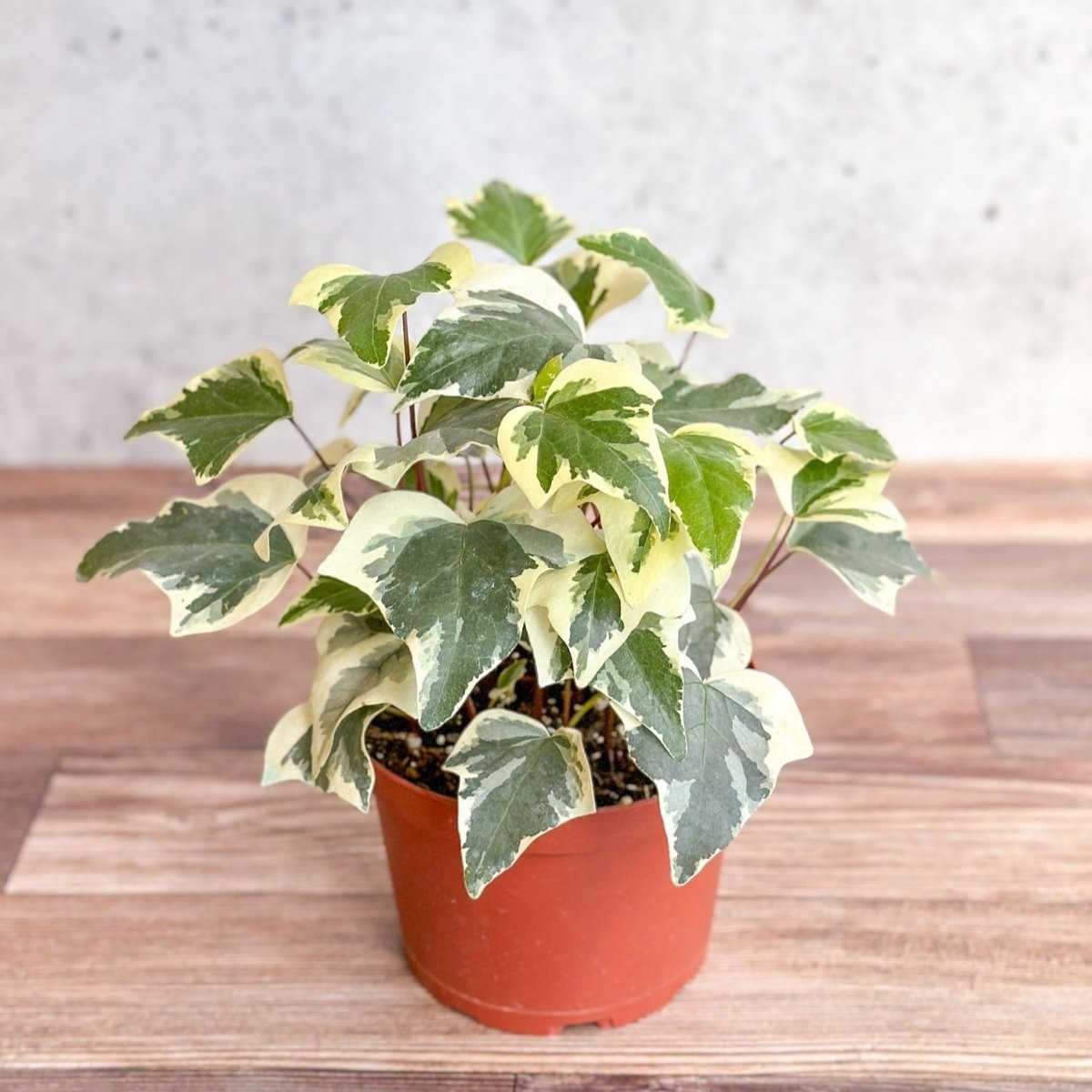
Algerian Ivy is a fast-growing evergreen vine that can reach up to 10 feet in height and spread about 3 feet wide. It features glossy, dark green leaves with a heart-like shape, often measuring 4 to 5 inches across. Some cultivars even have a creamy white margin around the edges, enhancing their visual appeal.
This ivy variety is ideal for growing on trellises, walls, or even as a groundcover. Its lush foliage and fast growth make it a popular choice for covering unattractive surfaces. It also performs well on slopes, helping to prevent soil erosion while adding greenery to the landscape.
Algerian Ivy is highly adaptable, tolerating both full sun and partial shade. It can withstand some drought conditions but prefers consistently well-drained soil. Regular watering and occasional pruning will keep it looking vibrant and healthy throughout the year.
Irish Ivy (Hedera hibernica)
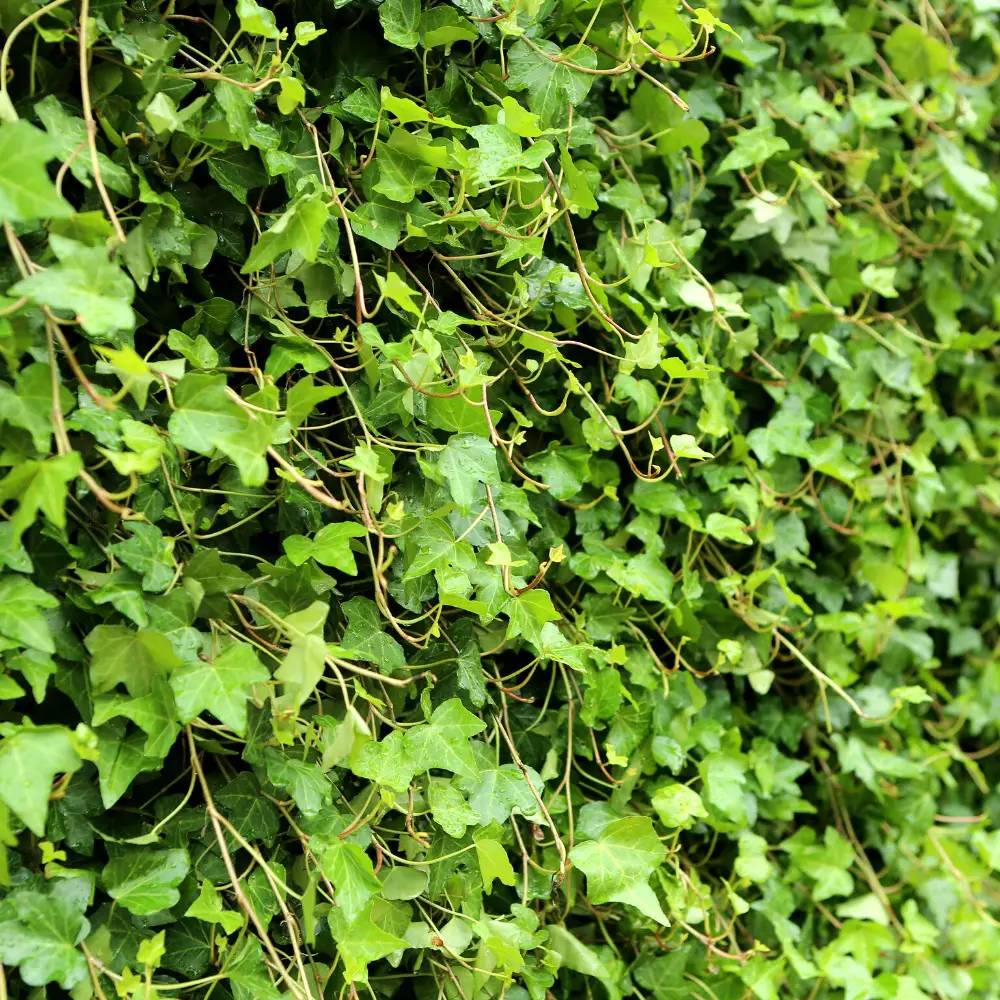
Irish Ivy closely resembles English Ivy in both appearance and growth habits. This vigorous climber is well-suited for USDA hardiness zones 5 to 9 and thrives in cool, humid climates. Its lush, dark green leaves create a dense covering over walls, fences, and garden beds, making it a popular choice for landscaping.
Due to its aggressive growth, Irish Ivy is sometimes considered invasive in certain regions. Some local authorities actively manage its spread to prevent it from overtaking native vegetation. However, in controlled environments, it serves as a beautiful groundcover or climbing vine that enhances outdoor spaces.
For best results, plant Irish Ivy in well-drained soil with partial to full shade. Regular pruning will help keep its growth in check, ensuring it remains a decorative asset rather than a nuisance.
Japanese Ivy (Hedera rhombea)
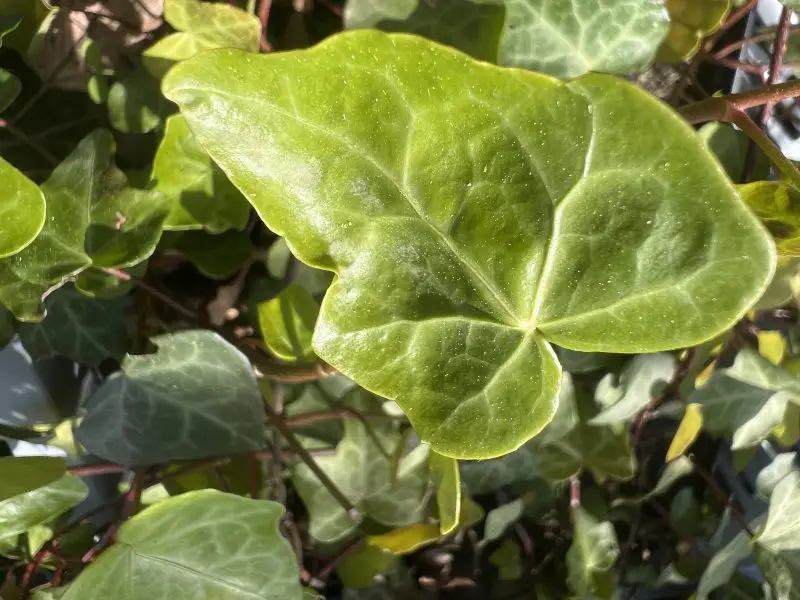
Japanese Ivy is a lesser-known variety that originates from East Asia, where it thrives on rocky slopes, tree trunks, and forest floors. It is a vigorous climber with evergreen foliage, making it an excellent choice for vertical gardening.
One of the most distinctive features of Japanese Ivy is its purplish stems and glossy, diamond-shaped leaves. During the growing season, it produces clusters of yellowish-green flowers, which later develop into small, dark berries. When cross-pollinated, some plants may even display stunning creamy streaks on their leaves.
This ivy prefers well-drained, fertile soil with a pH level of 6.0 to 7.5. It does best in neutral to slightly acidic conditions and can grow well in both sunny and shaded environments. With proper care, Japanese Ivy can become a striking addition to any garden or landscape.
Russian Ivy (Hedera pastuchovii)
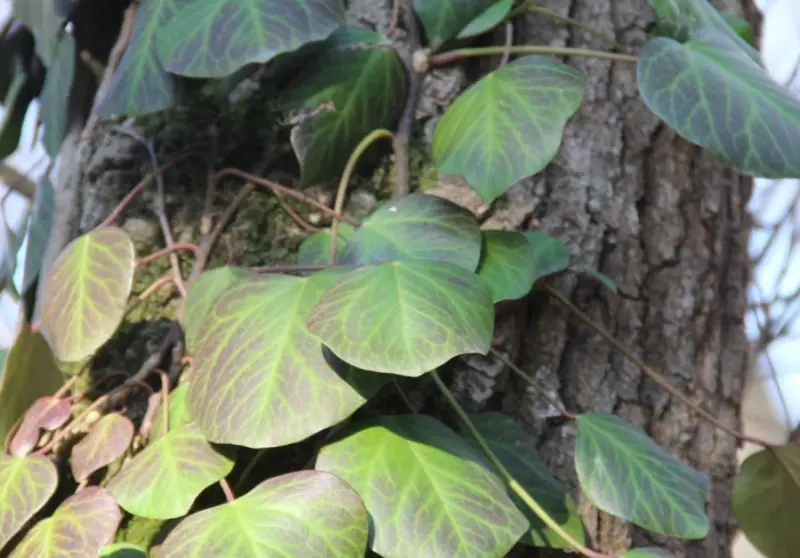
Native to Russia, Armenia, and Iran, Russian Ivy is a vigorous evergreen climber that can reach impressive heights of up to 100 feet when given proper support. Unlike other ivy varieties that sprawl along the ground, this plant prefers vertical surfaces, making it an excellent choice for trellises, walls, and fences.
Its heart-shaped leaves are mid-green and slightly elongated, adding a touch of elegance to any space. Russian Ivy thrives in USDA hardiness zones 7 to 12 but can be grown in colder regions with proper winter protection. This variety flourishes in well-drained soil and benefits from occasional pruning to manage its rapid growth.
Due to its climbing nature, Russian Ivy is perfect for covering large structures and creating lush, green backdrops. However, it requires sturdy support as it grows, ensuring it remains a striking and well-maintained feature in any garden.
Needlepoint Ivy
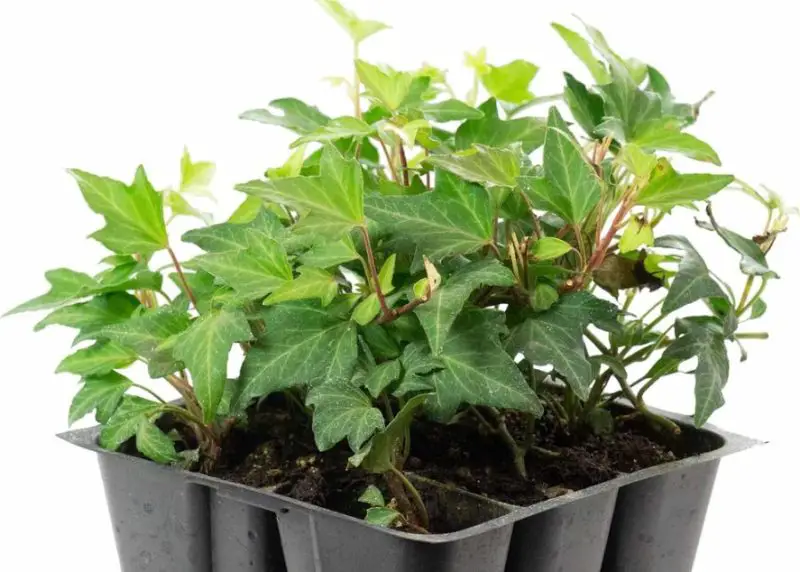
A unique cultivar of English Ivy, Needlepoint Ivy is prized for its small, closely spaced leaves with sharply pointed lobes. This variety has a delicate and refined appearance, making it a popular choice for ornamental use in both indoor and outdoor settings.
Needlepoint Ivy is commonly found in hanging baskets, cascading elegantly over the edges, or adorning stone walls as a clinging vine. It grows up to 3 feet in height, making it an ideal choice for containers, trellises, and decorative plantings. Its deep green foliage adds texture and depth to any arrangement.
This ivy variety thrives in partial shade to full sun and prefers moist, well-drained soil. Regular trimming helps maintain its compact shape, making it a low-maintenance yet visually appealing plant for various landscaping needs.
German Ivy (Delairea odorata)
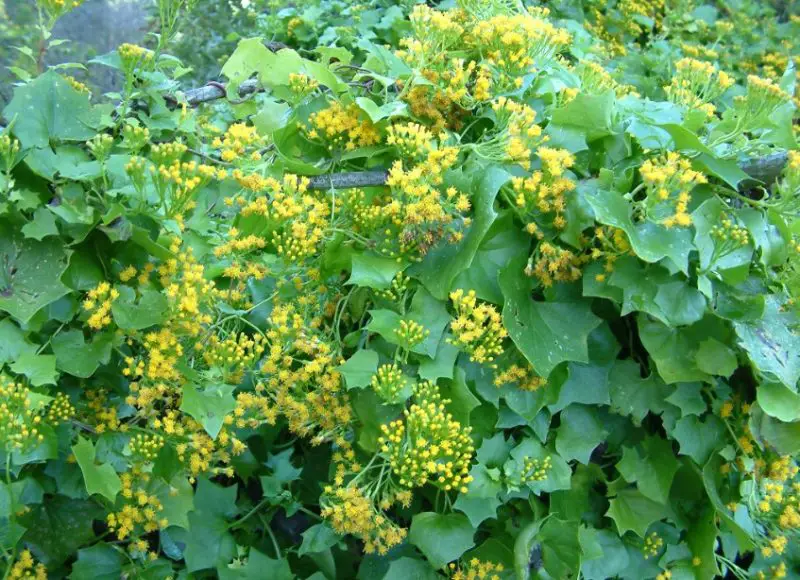
Also known as Cape Ivy, German Ivy is a fast-growing climber native to South Africa but commonly found along the California coast. This species thrives in moist environments such as forests and wetlands but struggles in dry conditions.
During periods of drought, German Ivy may wither, but it quickly revives with the return of rain. Its vibrant green, lobed leaves and twining growth habit make it a lush addition to gardens and natural landscapes. It can be an aggressive grower, so careful pruning is necessary to prevent it from spreading uncontrollably.
German Ivy prefers well-drained, nutrient-rich soil and moderate sunlight. Due to its ability to grow rapidly, it is often used for erosion control and ground cover in areas with ample water availability.
Bullock’s Heart Ivy
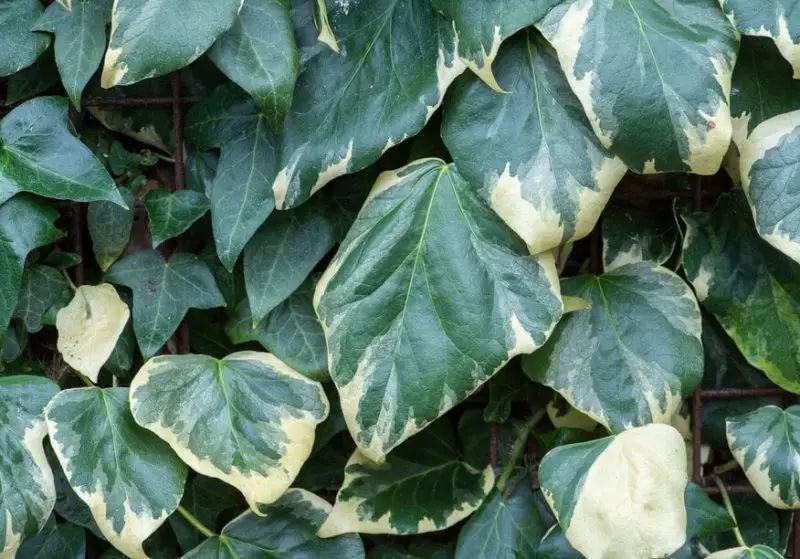
Bullock’s Heart Ivy is a distinctive variety known for producing a variety of flowers throughout the year. While it may not be the tallest ivy, it can still reach an impressive 40 feet in height, thriving best in USDA hardiness zones 6 to 9.
This ivy features lush green foliage that provides dense coverage, making it suitable for climbing walls, fences, or trellises. The flowers add an extra layer of beauty, enhancing the plant’s ornamental appeal. It is a relatively low-maintenance species, requiring minimal care beyond occasional watering and pruning.
Bullock’s Heart Ivy is an excellent choice for gardeners looking for a fast-growing vine that provides both greenery and seasonal blooms. Its adaptability to different light conditions makes it a versatile addition to outdoor spaces.
Swedish Ivy (Plectranthus australis)
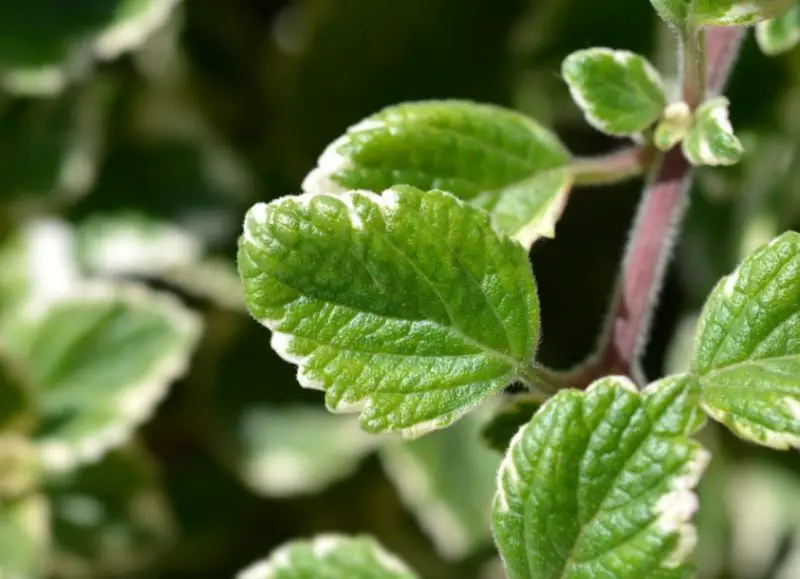
Unlike true ivy species, Swedish Ivy is a trailing plant known for its lush foliage and easy-care nature. It is best suited for USDA hardiness zones 10 and 11, where it thrives in warm climates with partial shade.
Swedish Ivy is characterized by its erect stems and vibrant green leaves, making it a popular houseplant. It grows well in hanging baskets, cascading beautifully over the edges, or as a decorative addition to patios and decks. The plant’s trailing vines can reach two to three feet, creating a charming, draping effect.
For best results, Swedish Ivy should be planted in well-drained, humus-rich soil. Regular watering and occasional pruning help maintain its attractive shape, making it a delightful choice for both indoor and outdoor settings.
Ivalace Ivy
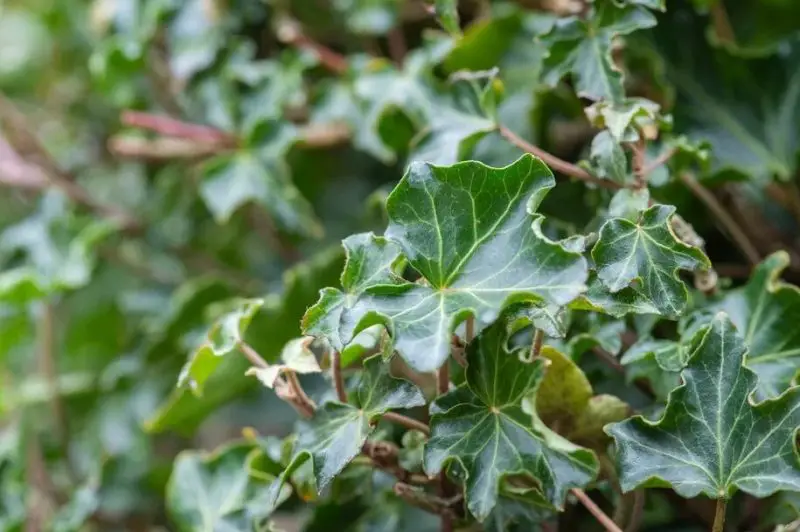
A striking English Ivy cultivar, Ivalace Ivy is known for its small, shiny leaves with a cupped, lace-like appearance. The edges of the leaves are uniquely curled, giving the plant a textured and decorative look.
Ivalace Ivy grows up to three feet tall and can spread up to four feet wide, making it an excellent choice for ground cover, climbing structures, or indoor planters. Its fast-growing nature makes it a favorite among gardeners looking for quick coverage with a touch of elegance.
To ensure healthy growth, Ivalace Ivy should be planted in a location sheltered from strong winds and extreme cold. It thrives in full to partial sunlight and prefers well-drained soil. With proper care, this ivy variety makes a stunning addition to any garden or indoor space.
Boston Ivy (Parthenocissus tricuspidata)
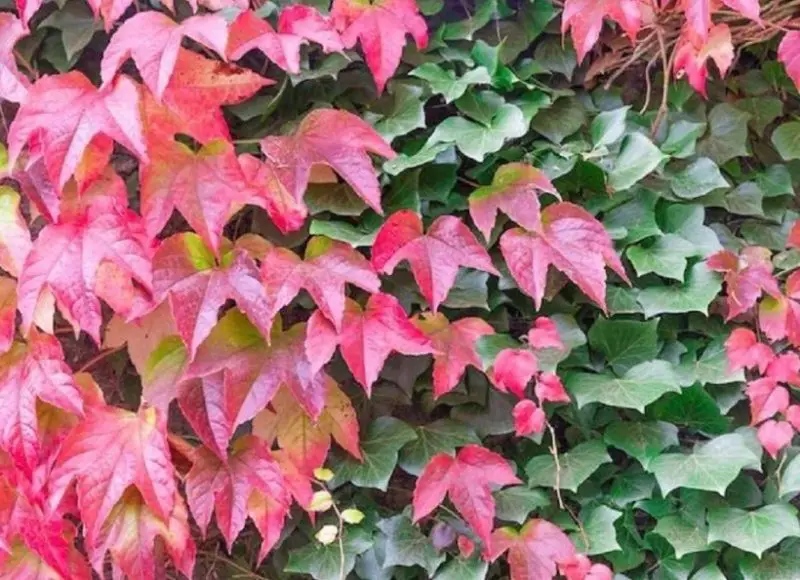
Boston Ivy, despite its name, is not a true ivy but belongs to the grape family (Vitaceae). Native to East Asia, this fast-growing deciduous vine is admired for its ability to climb walls, trellises, and fences using adhesive tendrils with small suction cups. Unlike traditional ivies, which rely on aerial rootlets, Boston Ivy clings securely without causing significant damage to masonry. Its lobed, glossy green leaves create a dense covering that provides a cooling effect during summer while transforming into a breathtaking display of red, orange, and purple hues in autumn.
In late spring to early summer, Boston Ivy produces small greenish-white flowers that are inconspicuous but attract pollinators such as bees. These blooms give way to tiny blue-black berries, which resemble miniature grapes and serve as a valuable food source for birds during colder months. Although the berries are inedible for humans, their presence enhances the vine’s appeal in natural landscapes. This species is often planted for its seasonal beauty, erosion control, and as a privacy screen, making it a favorite among gardeners and landscape designers.
Thriving in USDA hardiness zones 4 to 8, Boston Ivy adapts well to various soil types as long as they are well-drained. It prefers full sun to partial shade, with brighter light conditions intensifying its autumn colors. This hardy vine requires minimal maintenance once established and is highly resistant to pests and diseases. With proper care and pruning, Boston Ivy can provide long-lasting aesthetic value to both urban and suburban settings.
Goldchild Ivy
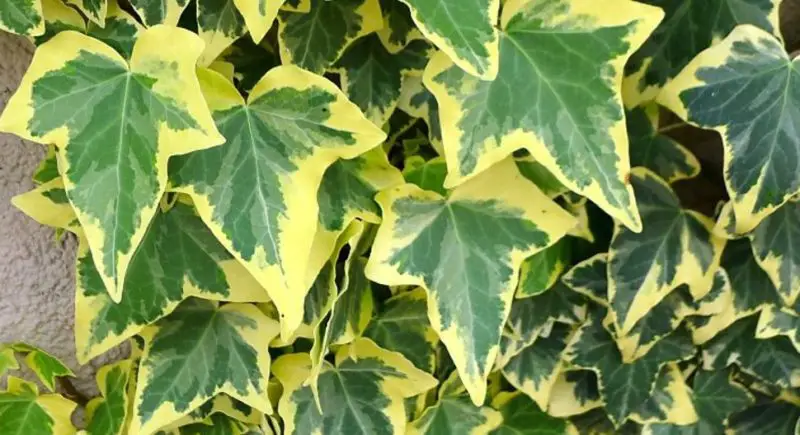
Goldchild Ivy is a stunning cultivar of English Ivy (Hedera helix), recognized for its vibrant foliage. Its five-lobed leaves feature a striking blend of dark green and bright golden-yellow edges, creating an eye-catching contrast. This variegation makes it a popular choice for ornamental purposes, whether in gardens, containers, or hanging baskets. As an evergreen vine, it retains its color year-round, adding brightness to both indoor and outdoor spaces, even during the colder months.
This variety of ivy exhibits a dense, trailing growth habit, making it an excellent ground cover for suppressing weeds or cascading over walls and planters. It typically reaches a height of about 3 feet and spreads up to 2 feet when grown in optimal conditions. Goldchild Ivy thrives in partial shade to full sun, with its colors becoming more pronounced in brighter light. Its leaves have a leathery texture with prominent veins, giving it a robust appearance while remaining soft to the touch.
Hardy in USDA zones 5 to 9, Goldchild Ivy is relatively low-maintenance and adaptable to different soil types, provided they are well-drained. It benefits from occasional pruning to maintain its shape and encourage bushier growth. While it can tolerate some drought, regular watering ensures its variegation remains vibrant. Whether used as a ground cover, a climbing vine, or an indoor plant, Goldchild Ivy adds elegance and texture to any environment.
Himalayan Ivy
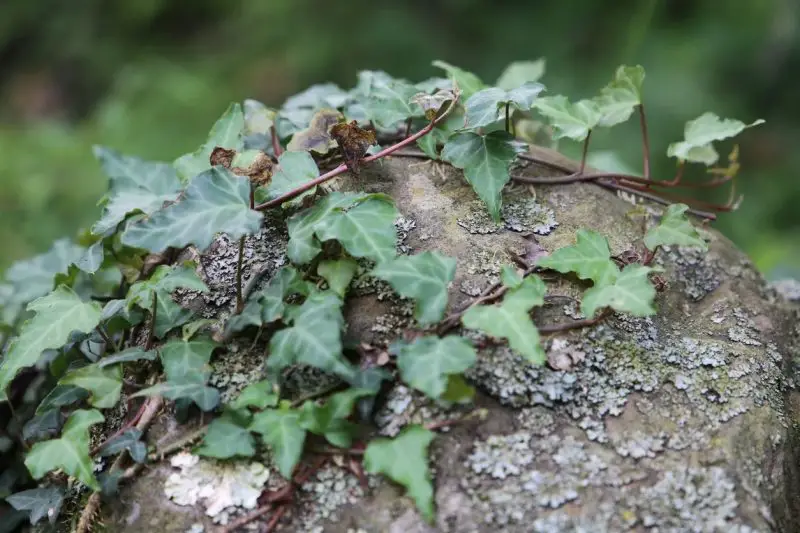
Himalayan Ivy (Hedera nepalensis) is a unique and exotic ivy species native to the mountainous regions of Asia, particularly Nepal, India, and Bhutan. It is distinguished by its deep green, diamond-shaped leaves that can grow up to 6 inches in length. The leaves feature prominent, light-colored veins, which enhance their visual appeal and give them a textured look. Unlike many other ivies, Himalayan Ivy has a slightly looser growth habit, making it ideal for covering large areas while still allowing glimpses of the underlying structure.
This ivy is a vigorous climber, capable of reaching heights of up to 100 feet when provided with adequate support. It uses aerial rootlets to attach itself to trees, walls, or rocky surfaces, making it a perfect choice for shaded gardens and forested landscapes. While it grows more sparsely than English Ivy, it provides excellent coverage and can create a lush, green backdrop in both natural and cultivated settings. Himalayan Ivy is also resistant to deer and other browsing animals, adding to its appeal in wildlife-prone areas.
Himalayan Ivy thrives in USDA zones 7 to 10, preferring partial to full shade with moist, well-drained soil. It performs exceptionally well in cooler, high-altitude climates but can adapt to temperate regions with proper care. Regular pruning helps control its spread and encourages fuller growth. This ivy is an excellent choice for erosion control on slopes or for adding a touch of wilderness to gardens and urban landscapes.
Glacier Ivy
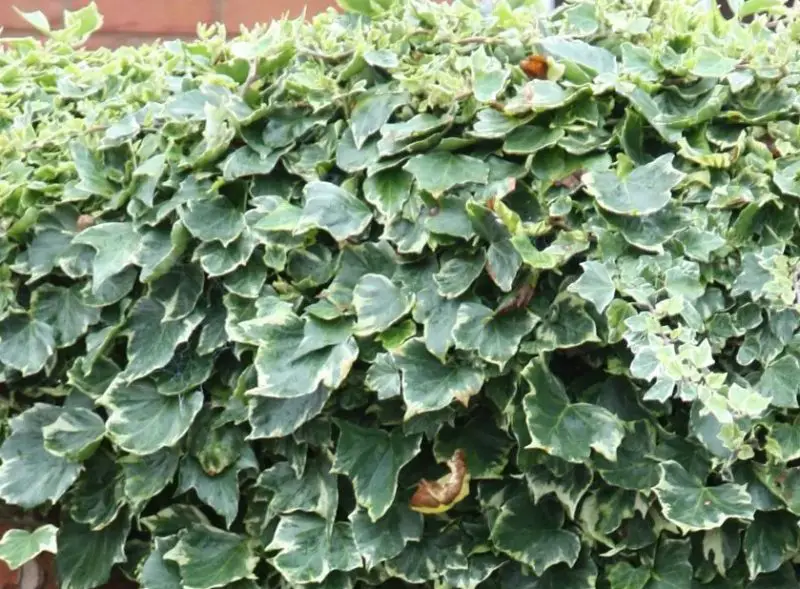
Glacier Ivy is a highly ornamental variety of English Ivy (Hedera helix), known for its beautiful variegated leaves. Its foliage features a mix of green, creamy-white, and silvery-gray tones, giving it a soft, frosted appearance. This variegation makes it a standout plant for both indoor and outdoor use, as it adds texture and lightness to any setting. Its delicate coloration makes it especially popular as an indoor plant, where it can thrive in controlled environments with bright, indirect light.
This ivy is a moderate grower, reaching a mature height of about 6 to 10 feet with proper support. It is well-suited for hanging baskets, high shelves, and decorative pots, where its trailing vines can drape elegantly over the edges. While it can climb, it is often used as ground cover in gardens, where its variegated leaves create a striking contrast against darker green plants. Glacier Ivy is less aggressive than some other ivy varieties, making it easier to manage in smaller spaces.
Thriving in USDA hardiness zones 5 to 9, Glacier Ivy prefers indirect sunlight but can tolerate some shade. It requires well-drained soil and moderate watering to maintain its variegation. Too much direct sun can cause leaf scorch, while excessive shade may diminish its vibrant colors. Regular pruning keeps it compact and encourages new growth, making it an excellent choice for decorative arrangements, patios, and vertical gardens.
Bettina Ivy
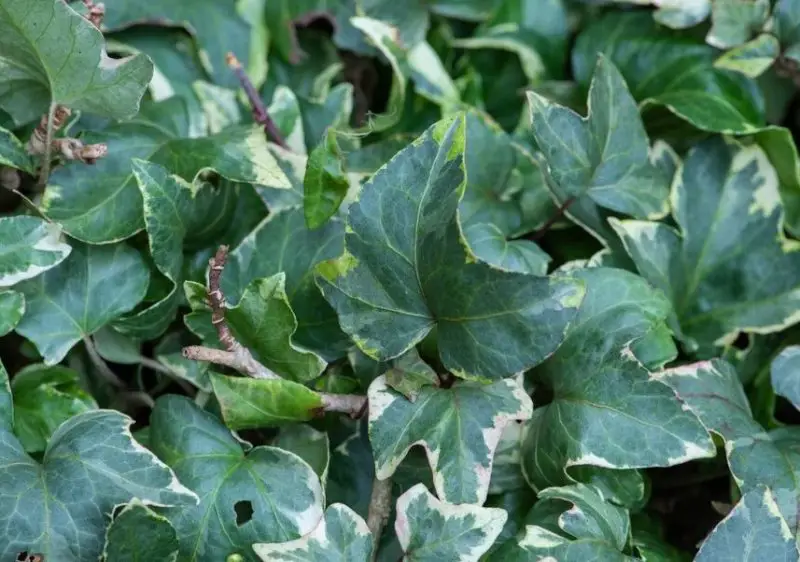
Bettina Ivy is a compact and attractive cultivar of English Ivy (Hedera helix), prized for its small, rounded leaves with a rich moss-green center and creamy-white edges. This variety is particularly popular as a houseplant due to its controlled growth habit and easy maintenance. The dense foliage creates a soft, elegant effect, making it ideal for desks, countertops, or decorative shelves.
Unlike more aggressive ivy varieties, Bettina Ivy maintains a manageable size, growing up to 3 feet in height and spreading up to 2 feet. It can be trained to climb with support or left to trail in hanging baskets. Its slightly crinkled leaves give it a unique texture that distinguishes it from other ivies. Bettina Ivy is also well-suited for use in terrariums and fairy gardens, where its small leaves add a lush, miniature landscape effect.
Hardy in USDA zones 6 to 9, Bettina Ivy thrives in bright, indirect light but can tolerate some shade. It prefers well-drained soil and requires occasional pruning to maintain its compact shape. While it is primarily grown indoors, it can also be used as ground cover in shaded gardens, where it forms a dense, low-growing mat. With proper care, Bettina Ivy remains a beautiful and versatile addition to any space.
Tripod Ivy
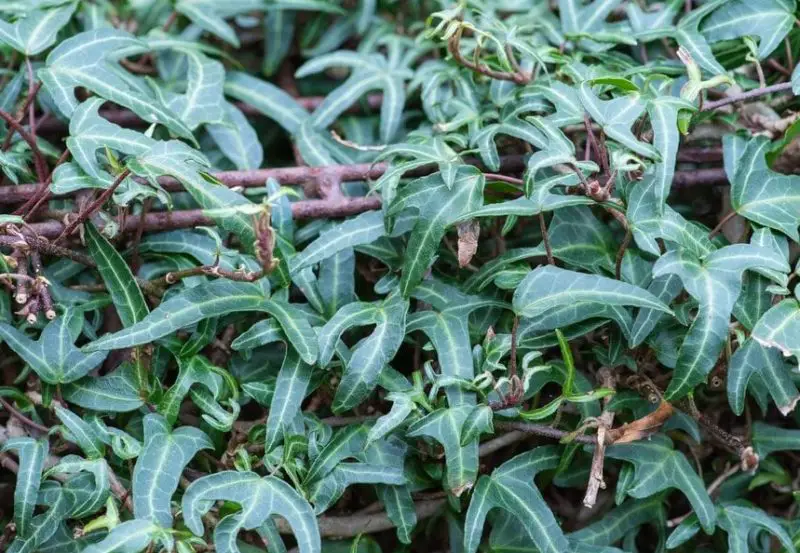
Tripod Ivy (Hedera helix ‘Tripod’) is a distinctive variety of English Ivy, named for its three-lobed leaves, which set it apart from the typical five-lobed structure found in most ivies. Its deep green foliage has a glossy texture, and its light-colored veins create a striking contrast that enhances its ornamental appeal. The unique leaf shape gives this ivy a slightly more modern and structured look, making it a favorite for contemporary garden designs.
This ivy is a vigorous climber and spreader, capable of reaching up to 13 feet in both height and width. It thrives in partial to full shade, making it an excellent choice for shady garden walls, trellises, and pergolas. The dense foliage provides excellent ground cover, helping to prevent soil erosion while adding a rich green backdrop to landscapes. In tropical and Mediterranean climates, Tripod Ivy is particularly valued for its ability to create lush, shaded areas.
Hardy in USDA zones 6 to 9, Tripod Ivy is easy to grow and highly adaptable. It prefers moist, well-drained soil and benefits from occasional trimming to keep its growth in check. While it can tolerate drought once established, regular watering promotes healthier, fuller foliage. Whether used as a climbing vine, a ground cover, or a potted ornamental plant, Tripod Ivy adds a distinctive and elegant touch to any setting.
Golden Curl Ivy
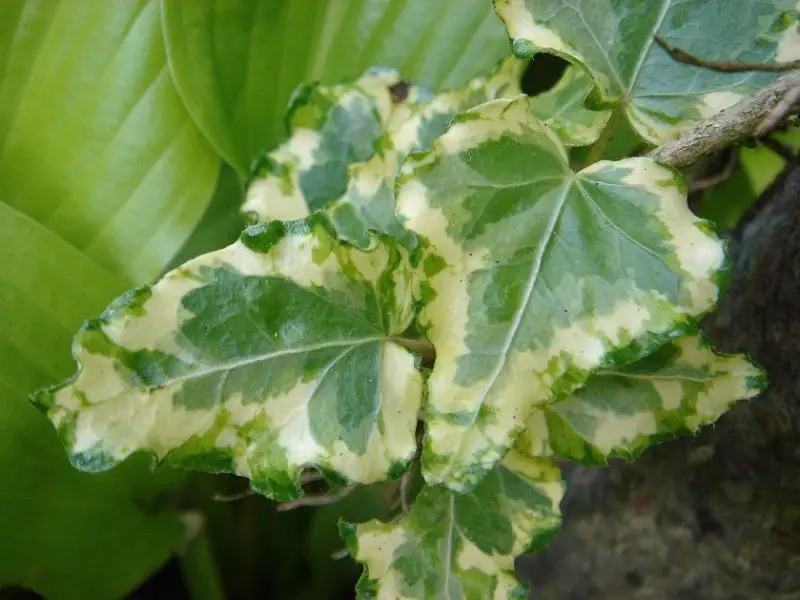
Golden Curl Ivy is a distinctive variety of English Ivy (Hedera helix) recognized for its uniquely curled leaves. The foliage has well-defined lobes, giving the leaves an almost pentagonal shape. What sets this ivy apart is its striking variegation—its leaf edges display a vibrant golden-yellow hue, sometimes appearing lemon-colored, while the centers remain deep green. This contrasting coloration makes it a visually appealing choice for decorative plantings.
Often grown as an indoor ornamental plant, Golden Curl Ivy adds a touch of elegance to homes, offices, and conservatories. Outdoors, it is frequently used as ground cover, a climbing vine, or as wall foliage to create a lush, artistic effect. The curly edges of the leaves give the plant a textured and voluminous appearance, making it a standout element in both container gardens and landscapes. When planted in contrast with darker green foliage, its bright edges create a dynamic and lively display.
This ivy can grow up to 40 feet tall with proper support, making it suitable for covering trellises, fences, and walls. It thrives in USDA hardiness zones 5 to 9 and prefers partial shade to full shade for optimal growth. While it can tolerate some sun exposure, too much direct sunlight may cause its vibrant yellow edges to fade. Regular pruning helps maintain its shape and encourages fuller growth, making Golden Curl Ivy a stunning addition to any setting.
Anne Marie Ivy
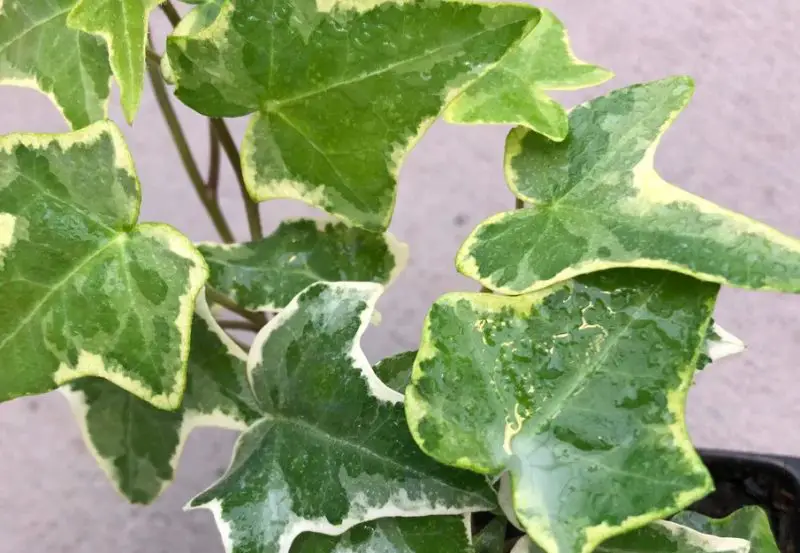
Anne Marie Ivy is a refined and elegant cultivar of English Ivy (Hedera helix) known for its soft, classical appearance. Unlike more deeply lobed ivies, Anne Marie Ivy features leaves with shallow indentations, giving them a smoother and more rounded form. The foliage is primarily a rich forest to hunter green, with delicate cream-colored edges and fine light-colored veins. Depending on the amount of sunlight it receives, its color can range from deep green in shaded areas to a lighter green with brighter variegation when exposed to more sunlight.
This ivy has a thick, lush growth habit, making it an excellent choice for decorative purposes both indoors and outdoors. It is often used to add texture and movement to displays, whether in hanging baskets, wall plantings, or as ground cover. The soft contrast between its green and cream hues makes it ideal for pairing with other plants in mixed arrangements. Indoors, it brings a fresh, natural aesthetic to spaces, while outdoors, it enhances the depth and texture of shaded gardens.
Anne Marie Ivy typically grows up to 4 feet tall with a spread of about 3 feet. It adapts well to various lighting conditions, thriving in full sun, partial shade, or full shade, though its variegation may become more pronounced with moderate sunlight exposure. Suitable for USDA zones 5 to 9, this ivy is relatively low-maintenance, requiring occasional pruning to keep its foliage dense and well-shaped. Whether used as a climbing vine, ground cover, or indoor accent, Anne Marie Ivy brings a refined and graceful beauty to any setting.






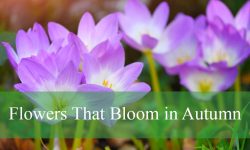
I have darker English ivy I fight every year for thriving tiger Lillie’s for 50 years. A lighter green thin ivy in growing inside the bed. It has a white flower. Over 10 days this vine destroyed this years Lillie’s. How do I spray the bed with Ortho Ivy without damaging the bulbs.
You can safely use Ortho Ivy Killer around your tiger lily bulbs, but you need to apply it very carefully to avoid harming them. Here’s how you can do it:
Spot Treatment Only – Do not spray the entire bed. Instead, use a small spray nozzle or a sponge/paintbrush to apply the Ortho directly to the ivy leaves. Avoid any contact with the tiger lily leaves or the soil directly over the bulbs.
Shield the Tiger Lilies – Place a piece of cardboard, plastic, or even an upside-down bucket over your tiger lilies while spraying. This will prevent any accidental drift onto your lilies.
Apply on a Calm Day – Spray only when there is no wind, and preferably in the early morning or evening to reduce evaporation and drift.
Repeat Carefully – You may need to reapply after a week or two as ivy can be stubborn. Monitor the lilies to ensure no accidental damage.
If the ivy is growing too close to the bulbs, you may want to hand-pull it or cut it back and then spot-treat the regrowth to protect your lilies further.